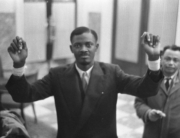At first glance, I Called Him Morgan could be considered fiction. Jazz trumpeter Lee Morgan miraculously appears in 1956 as a teenage phenom in Dizzy Gillespie’s band; shines with Art Blakey & the Jazz Messengers; leads his own quintet, performing his own compositions; and makes 25 albums for Blue Note Records, including crossover hits on the pop and R & B charts. He also was featured on famous sessions, such as John Coltrane’s classic “Blue Train.” His life descended into heroin, then recovery, through the love of an older woman, before newspapers covered his 1972 death like a modern-day “Frankie & Johnny” story.
But Swedish director Kasper Collin spent almost a decade uncovering and editing together the real people behind the legend, with the aid of archival photographs, performance clips, rare audio interviews, and conversations with friends, relatives, and witnesses he amazingly found, including noted jazz musicians. He waited four years just to be able to sit down at length with saxophonist and band mate Wayne Shorter, among other players. More, his documentary sensuously recreates the ambiance surrounding these lives, from North Carolina to New York City.
The story unfolds like tragic destiny, through the intersection of the lives of Morgan and his common-law wife, Helen. Jazz DJ and teacher Larry Reni Thomas recounts his surprise in learning that the husband of one of his older students in his African American history class had been Lee Morgan—she had returned to her hometown of Wilmington, North Carolina. In February 1996, he got Helen to sit down and record the first part of her memories. A month later, she died. Her voice from that cassette tape is featured throughout, but Collin also found the son she had given birth to at age 13 before she headed to the bright lights of the big city just a few years later, as well as girlfriends Morgan had before and during the time Helen managed his life and career.
Lee seems to appear out of Philadelphia into the jazz world like a mysterious gift. (With no other biographical background provided, I imagined a deal with the devil at a crossroads, like Robert Johnson, for talent in exchange for a short life.) His music is heard throughout, as various band members recall his sound and his personality, including drummer Albert “Tootie” Heath (a Heath Brother) and bass player Paul West, who first knew Morgan as a sharp-dressed man playing with Dizzy Gillespie’s Orchestra, who years later got West involved as an inspiring teacher at a Jazzmobile workshop. (West was at the New York Film Festival screenings of the film along with several other interviewees.) In addition to the live performance sets (some grainy from many sources, but illustrative), the marvelous photographs of recording sessions come from the unique collection of Francis Wolff, a founder of Blue Note, who was constantly snapping musicians with his camera as they played intensely and relaxed in camaraderie.
Helen resisted documentation, but the few informal photographs reveal a woman busy in her apartment kitchen, near the club Birdland and which doubled as an after-hours hangout for jazz musicians. She later moved with Lee up to the Bronx to try keep him sober and working, and during this time, Val Wilmer photographed and interviewed him. The extensive interviews with former bandmates detail the couple’s affection and interdependence. West credits her very specifically: “His life was restored by Helen, and it was a joy to watch.” However, the girlfriends are very specific on how Morgan needed to relax away from her smothering. His last encounter with Helen happened during a blizzard in February 1972. Collin, along with cinematographer Bradford Young, took advantage of snow storms during 2010–2012 to recapture the environment just as the witnesses describe it.
The director’s patience over many years in meticulously putting all these elements together—the voices, faces, music, headlines, photos, album covers, posters, performances, city scenes, and more—beautifully recover the memory and artistry of Lee Morgan and his milieu.







Leave A Comment